MailerLite vs Kit (ConvertKit): I Used Both — Here’s What You Should Know
I remember this exact moment — sitting at my desk with two tabs open:
MailerLite on one side, ConvertKit (now just called Kit) on the other.
I had finally committed to growing my list properly, but now I was stuck between these two tools — both popular, both highly recommended, and both claiming to be “the best for creators.”
And honestly?
Making this choice felt way harder than it should’ve been.
Why This Isn’t Just a Small Decision
When you pick an email marketing tool, you’re not just choosing a platform — you’re choosing the backbone of your communication, automations, and conversions.
And trust me, I’ve learned the hard way:
-
❌ Pick a tool that looks good but lacks power — and you’ll outgrow it fast
-
❌ Pick one that’s too complex — and you’ll waste hours setting up basic things
-
❌ Worst case? You burn time, lose subscribers, and have to switch later
So I Did What I Had To Do
I stopped overthinking it… and signed up for both.
I ran real email campaigns. Built automations. Designed newsletters. Sent broadcasts.
I used both MailerLite and Kit for my own business and clients — so I could finally see which one truly worked in practice, not just on paper.
And now, I’m breaking it all down for you — in plain English, no fluff, just real insights from someone who’s actually used both.
Let’s Start the battle of Mailerlite vs Convertkit 👇
Email Editor: Which One Makes Email Marketing Easier?
Both MailerLite and Kit say they’re easy to use — but from actually working with both, the experience was very different.
When I started using MailerLite’s drag-and-drop editor, it immediately felt smooth and flexible. I could add buttons, images, countdowns — and just move stuff around however I wanted. No stress, no limits. ✅
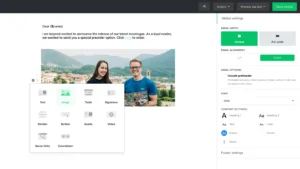
With Kit, even after their recent update, I was surprised there’s still no drag-and-drop. You’re stuck placing blocks in a set order. It’s fine for simple, text-first emails, but I quickly felt boxed in when I wanted more control. ❌
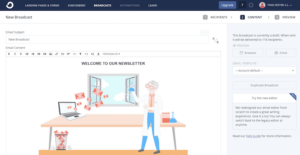
One thing that matters more than people realize? Mobile previews. MailerLite lets you check how your emails look on mobile while you build — super helpful since most readers open on phones. Kit doesn’t give you that same flexibility.
Also, I loved that MailerLite lets you save blocks and reuse them. I’ve reused the same promo section or footer across tons of campaigns. Kit doesn’t support this — every email is a fresh build, which adds up if you’re sending regularly. 🕒
Kit’s editor is clean and distraction-free, which is nice for quick writing. But when you’re doing actual email marketing — campaigns, launches, promos — that simplicity becomes a limit.
My verdict?
If you want full control, faster building, and modern design tools — MailerLite wins this round, hands down.
Kit is okay if you’re just sending basic, plain emails — but for real marketing? It falls short.
Score: MailerLite 1️⃣ – Kit 0️⃣
Design & Flexibility: How Creative Can You Get?
When you’re doing email marketing regularly, design isn’t just about looking good — it’s about building trust and keeping people engaged. And let me tell you, the design flexibility between these two tools is not equal.
MailerLite gives you way more creative room to play.
You get over 70+ pre-made templates (yep, really), all built to look modern and mobile-friendly. Whether I was sending newsletters, promos, or product launches, there was always something close to what I needed. Plus, if you’re like me and like to tweak things, you can go even further with custom HTML/CSS. 🙌
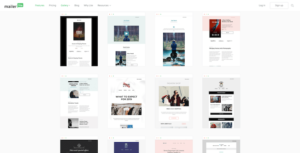
The catch? Those fancy templates only come with the paid plan or the 14-day free trial. Still, once you get access, the variety and polish are hard to beat.
Now Kit (ConvertKit) keeps things much simpler — maybe a little too simple for most marketers. You get around 20 basic templates, and while you can change fonts, colors, and images, the layout options are limited. It’s enough for clean, text-heavy emails… but not much beyond that.
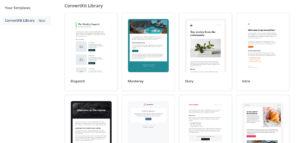
If your brand leans on design — or you just like having flexibility — Kit might leave you wanting more. I found myself hitting creative limits pretty fast.
My verdict?
If you want to create sharp, on-brand emails without hacking around, MailerLite wins again. It gives you real tools to bring your vision to life, while Kit is more of a “keep it plain and simple” type.
Score: MailerLite 2️⃣ – Kit 0️⃣
Email Automation: Who Makes It Easier (and Smarter)?
Here’s where things get interesting.
Both MailerLite and Kit offer automation workflows, but they go about it in very different ways — and depending on how you do email marketing, one approach might feel a lot smoother than the other.
When I used MailerLite, the visual automation builder was super intuitive. You can drag and drop steps, set triggers like email opens, link clicks, or form submissions, and see the whole workflow laid out like a mind map. For someone like me who wants to move fast without overcomplicating things, it just made sense. ✅
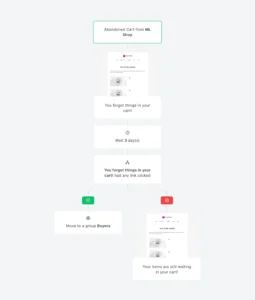
Kit (ConvertKit), on the other hand, takes a more advanced approach with its tagging and segmentation system. You can trigger automations based on really specific subscriber behaviors — like what link they clicked, what product they bought, or what tag they have. This gives you crazy precise targeting, but it also means the learning curve is a bit steeper.
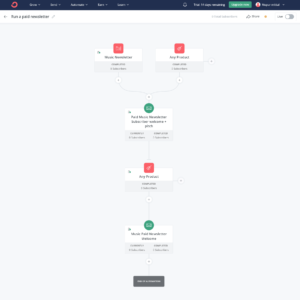
Honestly, Kit’s power shines when you want to go deep with personalization, but it can feel overwhelming if you’re just starting out or want something more visual and beginner-friendly.
Also worth noting:
-
MailerLite’s full automation builder is included on their free plan 🟢
-
Kit’s free plan only gives you one automated sequence 🟡 — which is… limiting, if you ask me.
My verdict?
Both platforms are solid here — MailerLite wins on simplicity and ease, while Kit wins on targeting power. It really depends on how complex your marketing needs are.
Score: MailerLite 3️⃣ – Kit 1️⃣
(But fair game — they both earn a point in automation.)
Registration Forms: Who Makes List Building Easier?
If you’re serious about email marketing, your forms matter — they’re how people actually join your list. And whether you’re collecting leads on your site or through a landing page, a smooth, flexible form builder makes all the difference.
Both MailerLite and Kit let you create GDPR-compliant forms — pop-ups, slide-ins, embedded forms, even full landing pages (yep, even if you don’t have a website). That’s a win for creators just getting started. 🙌
But here’s where things split:
MailerLite gives you way more customization. Want to change colors, fonts, layout, or even tweak how your form behaves? Super easy. You don’t need to touch code, and the editor actually feels fun to use.
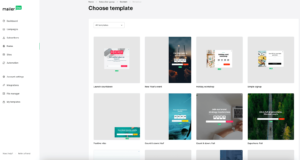
Kit? It works… but feels very limited. Like most things in Kit, the form builder keeps it minimal — which sounds great until you try to change something and realize you can’t. I’ve definitely had moments where I thought, “Wait, that’s it?”
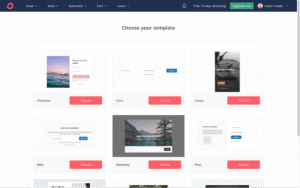
So while both tools cover the basics, MailerLite gives you more creative control, which matters when you’re trying to match your form to your brand or test different styles to boost sign-ups. 🎯
My verdict?
For building and customizing forms that actually look good and convert, MailerLite takes this one easily.
Score: MailerLite 4️⃣ – Kit 1️⃣
Landing Page Builder: Which One Actually Converts?
Even if you don’t have a website yet, a solid landing page can help you collect leads, promote offers, or launch something new. Luckily, both MailerLite and Kit include landing page builders on their free plans — but once again, the difference is in the details.
MailerLite gives you a lot more to work with.
From the start, I was impressed by the number of templates — clean, modern, and conversion-focused. But what really sold me was the ability to add high-impact elements like videos, testimonials, quizzes, and image carousels. These are the kind of things that boost engagement without needing outside tools. 🚀
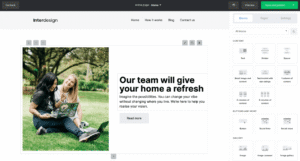
Kit’s landing pages, on the other hand, feel like a stripped-down version of what could’ve been a great builder. You can change basic colors and fonts to match your brand, but there’s not much else. No drag-and-drop, no real layout control — and surprisingly, you can’t even hyperlink an image. That one stung a bit.

Just like its email editor, Kit’s landing page builder feels more like a blank form than a design tool. It gets the job done, but you won’t have much freedom to make it yours.
My verdict?
For user experience, flexibility, and actually converting visitors into subscribers — MailerLite wins this one by a long shot.
Score: MailerLite 5️⃣ – Kit 1️⃣
Reporting: Who Helps You Actually Understand What’s Working?
Good reporting isn’t just about numbers — it’s about knowing what’s working, what’s flopping, and where to focus next. And when you’re sending regular campaigns, having that clear snapshot matters more than people think.
MailerLite gives you solid reporting tools right out of the box.
You can see open rates, click-throughs, unsubscribes, and which devices your readers are using — all from one place. It even goes a step further with purchase tracking for Shopify and WooCommerce, which I’ve personally found super helpful when running promos or launches. 🛍️
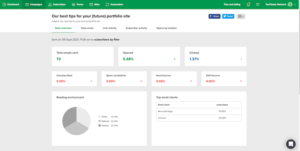
Kit’s reporting? Honestly, it feels like an afterthought.
You get the basics: opens, clicks, unsubscribes — and that’s it. There’s no overall dashboard, so if you want to see performance across multiple emails or track trends, you’re stuck checking them one by one. That gets real old real fast.
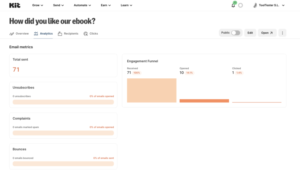
Especially when you’re trying to optimize and grow, having to dig around for basic info slows everything down. 📉
My verdict?
MailerLite clearly wins here with better reporting, easier access to data, and bonus features for ecommerce tracking.
Score: MailerLite 6️⃣ – Kit 1️⃣
Deliverability: Can Your Emails Actually Reach the Inbox?
Here’s the thing most beginners overlook: it doesn’t matter how beautiful your email is if it never lands in the inbox. Deliverability is everything — and it’s about more than just hitting “send.”
Both MailerLite and Kit do a solid job here. I tested both with real campaigns and was happy to see that deliverability wasn’t an issue on either platform. But they go about it a little differently.
MailerLite offers the essentials:
✅ Email authentication (SPF, DKIM)
✅ Bounce handling & spam complaint suppression
✅ Guided setup to protect your sender reputation
While it doesn’t have fancy features like a dedicated deliverability dashboard or access to feedback loops (FBL), I appreciated how beginner-friendly the setup was. You get solid protection without needing to be a tech expert. 👍
Kit (ConvertKit) also covers the basics well.
✅ SPF alignment
✅ Custom domain authentication
✅ Bounce support and warm-up tips
What Kit lacks in advanced visibility, it balances with clear guidance on maintaining sender health. That said, there’s no list cleaning integrations or deep dashboards — so if you’re after more in-depth data, you’ll need third-party tools.
My verdict?
It’s a tie. Both platforms give you a strong deliverability foundation.
-
MailerLite is slightly more beginner-friendly with hands-on guidance
-
Kit holds its own with all the right pieces in place for solid inbox placement
Score: MailerLite 7️⃣ – Kit 2️⃣
Integrations & Extras: Do They Play Nice With Other Tools?
If you’re like me, email marketing doesn’t live in a bubble. It connects with your store, your website, your forms, your payment systems — everything. So integrations? Yeah, they matter.
Kit (ConvertKit) connects with a solid list of tools — around 90 integrations, including big names like Shopify, WooCommerce, Stripe, WordPress, and Wix. You also get access to Zapier, which opens the door to thousands more workflows if you’re willing to set them up.
But here’s the catch: some of the “integrations” they list aren’t actually native. You’ll need to copy and paste HTML or mess with code to make things work — which feels a bit outdated, honestly. And strangely enough, no direct integrations with major CRMs like HubSpot or Salesforce, which could be a dealbreaker for advanced setups.
MailerLite is pretty much neck and neck here.
You get native integrations with tools like Shopify, WordPress, Stripe, and Zapier. Plus, if you (or your developer) want to go custom, MailerLite offers a well-documented API that gives you more control over how it plugs into your tech stack.
For most users — especially solopreneurs and small teams — both platforms offer enough to cover your main needs. But if you’re building a more advanced, multi-platform funnel, you might find yourself looking for workarounds with either.
My verdict?
It’s a tie. Both MailerLite and Kit offer solid integration options for everyday tools, but neither goes super deep when it comes to CRM or advanced ecosystem support.
Score: MailerLite 8️⃣ – Kit 3️⃣
Customer Support: Who’s Got Your Back When You Need Help?
Let’s be real — no matter how simple a tool is, you’re going to run into questions. And when that happens, having responsive, helpful support can save you a lot of frustration.
Luckily, both MailerLite and Kit offer solid support options. You get email and live chat on both platforms, and from my experience, the response times are pretty decent.
Kit’s support team was responsive and seemed to know their stuff. No canned answers, and they helped me troubleshoot without bouncing me around.
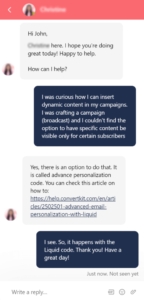
MailerLite’s support also impressed me. I noticed I was getting replies from the same small group of agents — and their responses were detailed, thoughtful, and clearly written by real people who understood the tool inside out. 🙌
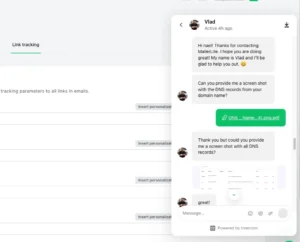
If you’re more of a DIY person, both platforms offer good help centers and tutorials — though I found MailerLite’s knowledge base a bit more comprehensive and easier to search.
My verdict?
This one’s close. Both are solid, but MailerLite edges out slightly thanks to its well-built knowledge base and consistently helpful replies.
Score: MailerLite 9️⃣ – Kit 4️⃣
Pricing: Which One Gives You More for Your Money?
Let’s talk money — because at the end of the day, your email tool needs to fit your budget and your goals.
When I tested both platforms, I was honestly surprised at how much Kit (ConvertKit) has leveled up its free plan. Their Newsletter Plan now gives you up to 10,000 subscribers and unlimited emails — and that’s a huge win if you’re a creator just starting out and want to build your audience without immediately pulling out the credit card. 🙌
MailerLite, on the other hand, caps its free plan at 1,000 subscribers and 12,000 emails/month. Still decent, but nowhere near Kit’s offering in terms of reach.
But here’s where the tables turn…
Once you move beyond the free tier, MailerLite becomes the more budget-friendly long-term option. Their Growing Business plan starts at just $10/month for 500 subscribers, and it stays affordable as your list grows — making it perfect for businesses thinking long-term.
Kit’s Creator Plan? Starts at $29/month for 1,000 subscribers, and it gets pricey pretty quickly at higher levels. Great if you’re monetizing early, but not ideal if you’re watching your marketing costs closely.
My verdict?
If you’re a new creator and want maximum reach for $0, Kit wins.
If you’re building a business and thinking about long-term growth + value? MailerLite is the better deal.
Score: MailerLite 9️⃣ – Kit 5️⃣
✅ Final Verdict: MailerLite or Kit — Which One Should You Choose?
After spending real time inside both platforms, running my own email campaigns, automations, and lead-gen setups — I can confidently say:
👉 MailerLite is the better all-around tool for most people.
It’s more flexible, easier to design with, and gives you more control over your automations, landing pages, and subscriber experience — all at a more affordable price point as you grow.
That said, Kit (formerly ConvertKit) isn’t a bad tool at all. In fact, if you’re a content-first creator who just wants to write and send, and you love the idea of a generous free plan to reach up to 10,000 subscribers — Kit might be a great place to start.
But here’s the honest truth from someone who’s tested both:
-
If you want a more visual experience, better templates, smoother editing, and great automation without a headache…
→ Go with MailerLite. -
If you want something simple, writing-focused, and you’re building an audience without needing fancy design or deep automations just yet…
→ Kit could work just fine.
But if you’re serious about growing, testing, and building a real email marketing machine, I’d say:
👉 Start with MailerLite. You’ll have more room to grow — and fewer limits.
Final Score: MailerLite 9️⃣ – Kit 5️⃣
If this helped you decide, I’d love to hear what you went with — and if you’re still stuck, drop your situation in the comments or send me a message. I’ll happily point you in the right direction based on your goals.
Here’s to sending better emails 🚀
— Kartik Pandit
Email Marketer & Tool Tester 🧪
